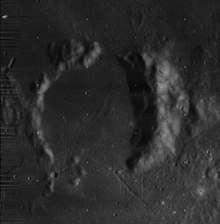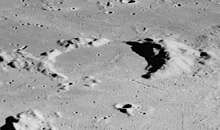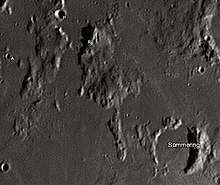Sömmering (crater)
Sömmering is the lava-flooded remains of a lunar impact crater on the eastern edge of the Mare Insularum. It was named after German doctor Samuel Thomas von Sömmerring.[1] To the southeast is the crater Mösting, and north of Sömmering lies a similar flooded crater designated Schröter. A rille designated Rima Schröter runs from the southeast of Schröter towards the east of Sömmering's outer rim.
 Lunar Orbiter 4 image | |
| Coordinates | 0.1°N 7.5°W |
|---|---|
| Diameter | 28 km |
| Depth | 1.0 km |
| Colongitude | 8° at sunrise |
| Eponym | Samuel Thomas von Sömmerring |

The western rim of this crater forms a slender arcing rise on the lunar mare, with a wide gap to the south and a narrow gap in the north. The eastern rim is much thicker in girth, and resembles a curved ridge. The interior floor is level and nearly featureless. The open southern end of this crater overlaps the lunar equator.
Satellite craters

By convention these features are identified on lunar maps by placing the letter on the side of the crater midpoint that is closest to Sömmering.
| Sömmering | Latitude | Longitude | Diameter |
|---|---|---|---|
| A | 1.1° N | 11.1° W | 3 km |
| P | 2.2° N | 10.3° W | 6 km |
| R | 1.9° N | 9.8° W | 17 km |
References
- "Sömmering (crater)". Gazetteer of Planetary Nomenclature. USGS Astrogeology Research Program.
- Andersson, L. E.; Whitaker, E. A. (1982). NASA Catalogue of Lunar Nomenclature. NASA RP-1097.CS1 maint: ref=harv (link)
- Bussey, B.; Spudis, P. (2004). The Clementine Atlas of the Moon. New York: Cambridge University Press. ISBN 978-0-521-81528-4.CS1 maint: ref=harv (link)
- Cocks, Elijah E.; Cocks, Josiah C. (1995). Who's Who on the Moon: A Biographical Dictionary of Lunar Nomenclature. Tudor Publishers. ISBN 978-0-936389-27-1.CS1 maint: ref=harv (link)
- McDowell, Jonathan (July 15, 2007). "Lunar Nomenclature". Jonathan's Space Report. Retrieved 2007-10-24.CS1 maint: ref=harv (link)
- Menzel, D. H.; Minnaert, M.; Levin, B.; Dollfus, A.; Bell, B. (1971). "Report on Lunar Nomenclature by the Working Group of Commission 17 of the IAU". Space Science Reviews. 12 (2): 136–186. Bibcode:1971SSRv...12..136M. doi:10.1007/BF00171763.CS1 maint: ref=harv (link)
- Moore, Patrick (2001). On the Moon. Sterling Publishing Co. ISBN 978-0-304-35469-6.CS1 maint: ref=harv (link)
- Price, Fred W. (1988). The Moon Observer's Handbook. Cambridge University Press. ISBN 978-0-521-33500-3.CS1 maint: ref=harv (link)
- Rükl, Antonín (1990). Atlas of the Moon. Kalmbach Books. ISBN 978-0-913135-17-4.CS1 maint: ref=harv (link)
- Webb, Rev. T. W. (1962). Celestial Objects for Common Telescopes (6th revised ed.). Dover. ISBN 978-0-486-20917-3.CS1 maint: ref=harv (link)
- Whitaker, Ewen A. (1999). Mapping and Naming the Moon. Cambridge University Press. ISBN 978-0-521-62248-6.CS1 maint: ref=harv (link)
- Wlasuk, Peter T. (2000). Observing the Moon. Springer. ISBN 978-1-85233-193-1.CS1 maint: ref=harv (link)
External links
| Wikimedia Commons has media related to Sommering (crater). |